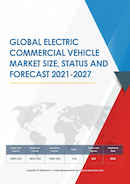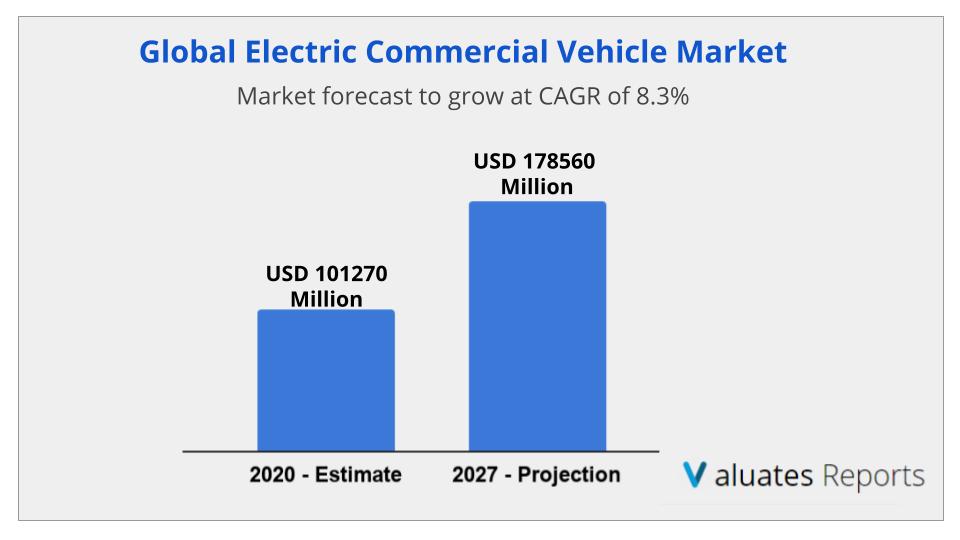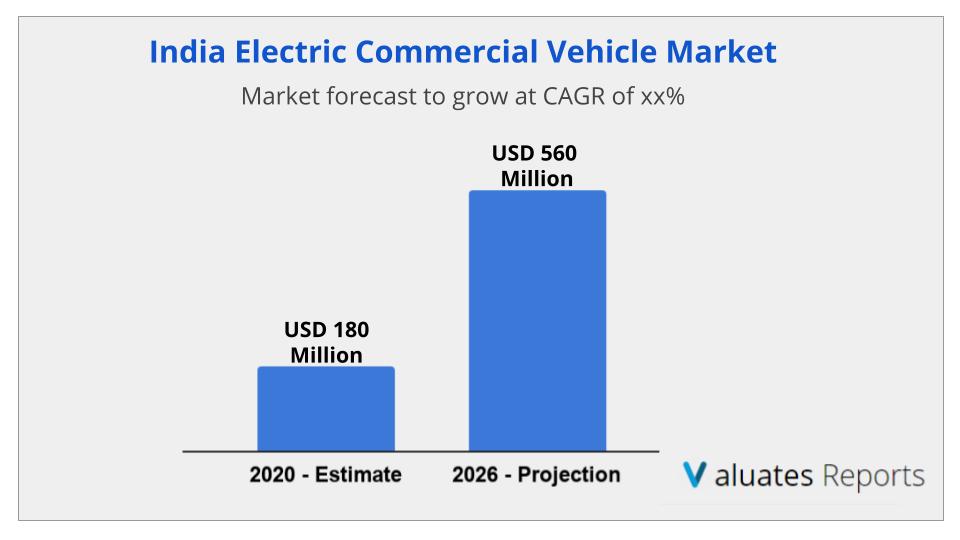

The global Electric Commercial Vehicle market size is projected to reach US$ 178560 million by 2027, from US$ 101270 million in 2020, at a CAGR of 8.3% during 2021-2027. Key factors driving the growth of the electric commercial vehicle market are strict government regulations regarding CO2 emissions, tightening of fuel economy, and an increase in the electrification of public transport fleets.
Innovations in battery pack technologies and a rise in usage of electric powertrains due to the growing demand for pure electric and plug-in hybrid vehicles will further propel the growth of the market during the forecast period.

This report focuses on Electric Commercial Vehicle volume and value at the global level, regional level, and company level. From a global perspective, this report represents the overall Electric Commercial Vehicle market size by analyzing historical data and prospects.
Mass electrification of public transport and the introduction of fuel-efficient electric buses will completely change mass transit worldwide in the coming years leading to a huge demand for the electric commercial vehicle market. Improved air quality and a decrease in noise levels are some of the positive end results that will influence the rising demand of the market during the forecast period. The entry of electric trucks into the logistics industry will further reduce the operating costs of companies like UPS and Pepsico leading to faster adoption and growing demand for the market.
A gradual tightening of fuel economy with strict CO2 standards and better accessibility to electric infrastructure is forcing manufacturers to shift to electric vehicles from conventional options. This is, in turn, accelerating the growth of the electric commercial vehicle market.
Environmental concerns regarding lithium-ion batteries and the race to develop eco-friendly, cost-effective, and increased battery capacity and range are giving rise to innovative and new developments in battery technology. For example, solid-state batteries can enable carmakers to extend the range of an EV, manufacture smaller and cheaper batteries, and enable faster charging times. This will in turn help in accelerating the growth of the electric commercial vehicle market during the forecast period.

The market for pure electric and plug-in hybrid vehicles has been growing aggressively increasing the demand for automotive electric powertrains. Huge private and government investments are further propelling the demand of the electric commercial vehicle market.
Based on type, the electric bus segment is expected to hold the largest electric commercial vehicle market share. The electric commercial vehicle market will continue to grow during the forecast period due to governments phasing out fossil fuel-run public transport and replacing it with electric buses.
Based on region, North America is expected to hold the largest electric commercial vehicle market share followed by Europe. Due to strict emission standards and supporting electric infrastructure and increasing logistics costs the demand for fuel-efficient and low emission vehicles is on a rise in Europe and North America and will continue to do so during the forecast period.
The India Electric Commercial Vehicle market size is projected to reach US$ 560 million by 2026, from US$ 180 million in 2020, at a CAGR of xx% during 2021-2026.

Electric Commercial Vehicle Market Segments
|
Report Metric |
Details |
|
Report Name |
Electric Commercial Vehicle Market |
|
The Market size value in 2020 |
USD 101270 Million |
|
The Revenue forecast in 2027 |
USD 178560 Million |
|
Growth Rate |
CAGR of 8.3% from 2021 to 2027 |
|
Base year considered |
2020 |
|
Forecast period |
2021-2027 |
|
Forecast units |
Value (USD) |
|
Segments covered |
Type, End-User, Offerings, and Region |
|
Report coverage |
Revenue & volume forecast, company share, competitive landscape, growth factors, and trends |
|
Geographic regions covered |
North America, Europe, Asia Pacific, Latin America, Middle East & Africa |
|
Key Manufacturers covered |
Tesla, Nissan, BYD, Daimler, ProterrA, LG Chem, Samsung, SDi, Panasonic, Delphi, ABB, Continental, Siemens, Mitsubishi Electric, Toshiba, Ballard Power Systems, Hydrogenics, ITM Power, Ceres Power, Plug Power, Nedstack, NuverA, AFCc, Toyota, Honda, Hyundai |
Ans. North America is expected to hold the largest Electric Commercial Vehicle market share during the forecast period. North America is a fast-growing market for electric commercial vehicles
Ans. Major factors driving the growth of the Electric Commercial Vehicle Market size are increasing electrification of public transport fleets, stringent government regulations, and advancements in battery pack technologies and electric powertrains..
Ans. Some key players operating in the Electric Commercial Vehicle market are Tesla, Nissan, BYD, Daimler, ProterrA, LG Chem, Samsung, SDi, Panasonic, Delphi, ABB, Continental, Siemens, Mitsubishi Electric, Toshiba
Ans. The global Electric Commercial Vehicle market size is projected to reach US$ 178560 million by 2027, from US$ 101270 million in 2020, at a CAGR of 8.3% during 2021-2027.
Ans. the forecast period for Electric Commercial Vehicle Market is 2021 to 2027
Table of Content
1 Electric Commercial Vehicle Market Overview
1.1 Product Overview and Scope of Electric Commercial Vehicle
1.2 Electric Commercial Vehicle Segment by Type
1.2.1 Global Electric Commercial Vehicle Production Growth Rate Comparison by Type 2020 VS 2026
1.2.2 Bus
1.2.3 Truck
1.2.4 Pick-Up Truck
1.2.5 Van
1.3 Electric Commercial Vehicle Segment by Application
1.3.1 Electric Commercial Vehicle Consumption Comparison by Application: 2020 VS 2026
1.3.2 Commercial
1.3.3 Private
1.4 Global Electric Commercial Vehicle Market by Region
1.4.1 Global Electric Commercial Vehicle Market Size Estimates and Forecasts by Region: 2020 VS 2026
1.4.2 North America Estimates and Forecasts (2015-2026)
1.4.3 Europe Estimates and Forecasts (2015-2026)
1.4.4 China Estimates and Forecasts (2015-2026)
1.4.5 Japan Estimates and Forecasts (2015-2026)
1.4.6 South Korea Estimates and Forecasts (2015-2026)
1.4.7 India Estimates and Forecasts (2015-2026)
1.5 Global Electric Commercial Vehicle Growth Prospects
1.5.1 Global Electric Commercial Vehicle Revenue Estimates and Forecasts (2015-2026)
1.5.2 Global Electric Commercial Vehicle Production Capacity Estimates and Forecasts (2015-2026)
1.5.3 Global Electric Commercial Vehicle Production Estimates and Forecasts (2015-2026)
1.6 Electric Commercial Vehicle Industry
1.7 Electric Commercial Vehicle Market Trends
2 Market Competition by Manufacturers
2.1 Global Electric Commercial Vehicle Production Capacity Market Share by Manufacturers (2015-2020)
2.2 Global Electric Commercial Vehicle Revenue Share by Manufacturers (2015-2020)
2.3 Market Share by Company Type (Tier 1, Tier 2 and Tier 3)
2.4 Global Electric Commercial Vehicle Average Price by Manufacturers (2015-2020)
2.5 Manufacturers Electric Commercial Vehicle Production Sites, Area Served, Product Types
2.6 Electric Commercial Vehicle Market Competitive Situation and Trends
2.6.1 Electric Commercial Vehicle Market Concentration Rate
2.6.2 Global Top 3 and Top 5 Players Market Share by Revenue
2.6.3 Mergers & Acquisitions, Expansion
3 Production and Capacity by Region
3.1 Global Production Capacity of Electric Commercial Vehicle Market Share by Regions (2015-2020)
3.2 Global Electric Commercial Vehicle Revenue Market Share by Regions (2015-2020)
3.3 Global Electric Commercial Vehicle Production Capacity, Revenue, Price and Gross Margin (2015-2020)
3.4 North America Electric Commercial Vehicle Production
3.4.1 North America Electric Commercial Vehicle Production Growth Rate (2015-2020)
3.4.2 North America Electric Commercial Vehicle Production Capacity, Revenue, Price and Gross Margin (2015-2020)
3.5 Europe Electric Commercial Vehicle Production
3.5.1 Europe Electric Commercial Vehicle Production Growth Rate (2015-2020)
3.5.2 Europe Electric Commercial Vehicle Production Capacity, Revenue, Price and Gross Margin (2015-2020)
3.6 China Electric Commercial Vehicle Production
3.6.1 China Electric Commercial Vehicle Production Growth Rate (2015-2020)
3.6.2 China Electric Commercial Vehicle Production Capacity, Revenue, Price and Gross Margin (2015-2020)
3.7 Japan Electric Commercial Vehicle Production
3.7.1 Japan Electric Commercial Vehicle Production Growth Rate (2015-2020)
3.7.2 Japan Electric Commercial Vehicle Production Capacity, Revenue, Price and Gross Margin (2015-2020)
3.8 South Korea Electric Commercial Vehicle Production
3.8.1 South Korea Electric Commercial Vehicle Production Growth Rate (2015-2020)
3.8.2 South Korea Electric Commercial Vehicle Production Capacity, Revenue, Price and Gross Margin (2015-2020)
3.9 India Electric Commercial Vehicle Production
3.9.1 India Electric Commercial Vehicle Production Growth Rate (2015-2020)
3.9.2 India Electric Commercial Vehicle Production Capacity, Revenue, Price and Gross Margin (2015-2020)
4 Global Electric Commercial Vehicle Consumption by Regions
4.1 Global Electric Commercial Vehicle Consumption by Regions
4.1.1 Global Electric Commercial Vehicle Consumption by Region
4.1.2 Global Electric Commercial Vehicle Consumption Market Share by Region
4.2 North America
4.2.1 North America Electric Commercial Vehicle Consumption by Countries
4.2.2 U.S.
4.2.3 Canada
4.3 Europe
4.3.1 Europe Electric Commercial Vehicle Consumption by Countries
4.3.2 Germany
4.3.3 France
4.3.4 U.K.
4.3.5 Italy
4.3.6 Russia
4.4 Asia Pacific
4.4.1 Asia Pacific Electric Commercial Vehicle Consumption by Region
4.4.2 China
4.4.3 Japan
4.4.4 South Korea
4.4.5 Taiwan
4.4.6 Southeast Asia
4.4.7 India
4.4.8 Australia
4.5 Latin America
4.5.1 Latin America Electric Commercial Vehicle Consumption by Countries
4.5.2 Mexico
4.5.3 Brazil
5 Electric Commercial Vehicle Production, Revenue, Price Trend by Type
5.1 Global Electric Commercial Vehicle Production Market Share by Type (2015-2020)
5.2 Global Electric Commercial Vehicle Revenue Market Share by Type (2015-2020)
5.3 Global Electric Commercial Vehicle Price by Type (2015-2020)
5.4 Global Electric Commercial Vehicle Market Share by Price Tier (2015-2020): Low-End, Mid-Range and High-End
6 Global Electric Commercial Vehicle Market Analysis by Application
6.1 Global Electric Commercial Vehicle Consumption Market Share by Application (2015-2020)
6.2 Global Electric Commercial Vehicle Consumption Growth Rate by Application (2015-2020)
7 Company Profiles and Key Figures in Electric Commercial Vehicle Business
7.1 TeslA
7.1.1 TeslA Electric Commercial Vehicle Production Sites and Area Served
7.1.2 TeslA Electric Commercial Vehicle Product Introduction, Application and Specification
7.1.3 TeslA Electric Commercial Vehicle Production Capacity, Revenue, Price and Gross Margin (2015-2020)
7.1.4 TeslA Main Business and Markets Served
7.2 Nissan
7.2.1 Nissan Electric Commercial Vehicle Production Sites and Area Served
7.2.2 Nissan Electric Commercial Vehicle Product Introduction, Application and Specification
7.2.3 Nissan Electric Commercial Vehicle Production Capacity, Revenue, Price and Gross Margin (2015-2020)
7.2.4 Nissan Main Business and Markets Served
7.3 BYD
7.3.1 BYD Electric Commercial Vehicle Production Sites and Area Served
7.3.2 BYD Electric Commercial Vehicle Product Introduction, Application and Specification
7.3.3 BYD Electric Commercial Vehicle Production Capacity, Revenue, Price and Gross Margin (2015-2020)
7.3.4 BYD Main Business and Markets Served
7.4 Daimler
7.4.1 Daimler Electric Commercial Vehicle Production Sites and Area Served
7.4.2 Daimler Electric Commercial Vehicle Product Introduction, Application and Specification
7.4.3 Daimler Electric Commercial Vehicle Production Capacity, Revenue, Price and Gross Margin (2015-2020)
7.4.4 Daimler Main Business and Markets Served
7.5 ProterrA
7.5.1 ProterrA Electric Commercial Vehicle Production Sites and Area Served
7.5.2 ProterrA Electric Commercial Vehicle Product Introduction, Application and Specification
7.5.3 ProterrA Electric Commercial Vehicle Production Capacity, Revenue, Price and Gross Margin (2015-2020)
7.5.4 ProterrA Main Business and Markets Served
7.6 LG Chem
7.6.1 LG Chem Electric Commercial Vehicle Production Sites and Area Served
7.6.2 LG Chem Electric Commercial Vehicle Product Introduction, Application and Specification
7.6.3 LG Chem Electric Commercial Vehicle Production Capacity, Revenue, Price and Gross Margin (2015-2020)
7.6.4 LG Chem Main Business and Markets Served
7.7 Samsung SDi
7.7.1 Samsung SDi Electric Commercial Vehicle Production Sites and Area Served
7.7.2 Samsung SDi Electric Commercial Vehicle Product Introduction, Application and Specification
7.7.3 Samsung SDi Electric Commercial Vehicle Production Capacity, Revenue, Price and Gross Margin (2015-2020)
7.7.4 Samsung SDi Main Business and Markets Served
7.8 Panasonic
7.8.1 Panasonic Electric Commercial Vehicle Production Sites and Area Served
7.8.2 Panasonic Electric Commercial Vehicle Product Introduction, Application and Specification
7.8.3 Panasonic Electric Commercial Vehicle Production Capacity, Revenue, Price and Gross Margin (2015-2020)
7.8.4 Panasonic Main Business and Markets Served
7.9 Delphi
7.9.1 Delphi Electric Commercial Vehicle Production Sites and Area Served
7.9.2 Delphi Electric Commercial Vehicle Product Introduction, Application and Specification
7.9.3 Delphi Electric Commercial Vehicle Production Capacity, Revenue, Price and Gross Margin (2015-2020)
7.9.4 Delphi Main Business and Markets Served
7.10 ABB
7.10.1 ABB Electric Commercial Vehicle Production Sites and Area Served
7.10.2 ABB Electric Commercial Vehicle Product Introduction, Application and Specification
7.10.3 ABB Electric Commercial Vehicle Production Capacity, Revenue, Price and Gross Margin (2015-2020)
7.10.4 ABB Main Business and Markets Served
7.11 Continental
7.11.1 Continental Electric Commercial Vehicle Production Sites and Area Served
7.11.2 Continental Electric Commercial Vehicle Product Introduction, Application and Specification
7.11.3 Continental Electric Commercial Vehicle Production Capacity, Revenue, Price and Gross Margin (2015-2020)
7.11.4 Continental Main Business and Markets Served
7.12 Siemens
7.12.1 Siemens Electric Commercial Vehicle Production Sites and Area Served
7.12.2 Siemens Electric Commercial Vehicle Product Introduction, Application and Specification
7.12.3 Siemens Electric Commercial Vehicle Production Capacity, Revenue, Price and Gross Margin (2015-2020)
7.12.4 Siemens Main Business and Markets Served
7.13 Mitsubishi Electric
7.13.1 Mitsubishi Electric Electric Commercial Vehicle Production Sites and Area Served
7.13.2 Mitsubishi Electric Electric Commercial Vehicle Product Introduction, Application and Specification
7.13.3 Mitsubishi Electric Electric Commercial Vehicle Production Capacity, Revenue, Price and Gross Margin (2015-2020)
7.13.4 Mitsubishi Electric Main Business and Markets Served
7.14 ToshibA
7.14.1 ToshibA Electric Commercial Vehicle Production Sites and Area Served
7.14.2 ToshibA Electric Commercial Vehicle Product Introduction, Application and Specification
7.14.3 ToshibA Electric Commercial Vehicle Production Capacity, Revenue, Price and Gross Margin (2015-2020)
7.14.4 ToshibA Main Business and Markets Served
7.15 Ballard Power Systems
7.15.1 Ballard Power Systems Electric Commercial Vehicle Production Sites and Area Served
7.15.2 Ballard Power Systems Electric Commercial Vehicle Product Introduction, Application and Specification
7.15.3 Ballard Power Systems Electric Commercial Vehicle Production Capacity, Revenue, Price and Gross Margin (2015-2020)
7.15.4 Ballard Power Systems Main Business and Markets Served
7.16 Hydrogenics
7.16.1 Hydrogenics Electric Commercial Vehicle Production Sites and Area Served
7.16.2 Hydrogenics Electric Commercial Vehicle Product Introduction, Application and Specification
7.16.3 Hydrogenics Electric Commercial Vehicle Production Capacity, Revenue, Price and Gross Margin (2015-2020)
7.16.4 Hydrogenics Main Business and Markets Served
7.17 ITM Power
7.17.1 ITM Power Electric Commercial Vehicle Production Sites and Area Served
7.17.2 ITM Power Electric Commercial Vehicle Product Introduction, Application and Specification
7.17.3 ITM Power Electric Commercial Vehicle Production Capacity, Revenue, Price and Gross Margin (2015-2020)
7.17.4 ITM Power Main Business and Markets Served
7.18 Ceres Power
7.18.1 Ceres Power Electric Commercial Vehicle Production Sites and Area Served
7.18.2 Ceres Power Electric Commercial Vehicle Product Introduction, Application and Specification
7.18.3 Ceres Power Electric Commercial Vehicle Production Capacity, Revenue, Price and Gross Margin (2015-2020)
7.18.4 Ceres Power Main Business and Markets Served
7.19 Plug Power
7.19.1 Plug Power Electric Commercial Vehicle Production Sites and Area Served
7.19.2 Plug Power Electric Commercial Vehicle Product Introduction, Application and Specification
7.19.3 Plug Power Electric Commercial Vehicle Production Capacity, Revenue, Price and Gross Margin (2015-2020)
7.19.4 Plug Power Main Business and Markets Served
7.20 Nedstack
7.20.1 Nedstack Electric Commercial Vehicle Production Sites and Area Served
7.20.2 Nedstack Electric Commercial Vehicle Product Introduction, Application and Specification
7.20.3 Nedstack Electric Commercial Vehicle Production Capacity, Revenue, Price and Gross Margin (2015-2020)
7.20.4 Nedstack Main Business and Markets Served
7.21 NuverA
7.21.1 NuverA Electric Commercial Vehicle Production Sites and Area Served
7.21.2 NuverA Electric Commercial Vehicle Product Introduction, Application and Specification
7.21.3 NuverA Electric Commercial Vehicle Production Capacity, Revenue, Price and Gross Margin (2015-2020)
7.21.4 NuverA Main Business and Markets Served
7.22 AFCc
7.22.1 AFCc Electric Commercial Vehicle Production Sites and Area Served
7.22.2 AFCc Electric Commercial Vehicle Product Introduction, Application and Specification
7.22.3 AFCc Electric Commercial Vehicle Production Capacity, Revenue, Price and Gross Margin (2015-2020)
7.22.4 AFCc Main Business and Markets Served
7.23 ToyotA
7.23.1 ToyotA Electric Commercial Vehicle Production Sites and Area Served
7.23.2 ToyotA Electric Commercial Vehicle Product Introduction, Application and Specification
7.23.3 ToyotA Electric Commercial Vehicle Production Capacity, Revenue, Price and Gross Margin (2015-2020)
7.23.4 ToyotA Main Business and Markets Served
7.24 HondA
7.24.1 HondA Electric Commercial Vehicle Production Sites and Area Served
7.24.2 HondA Electric Commercial Vehicle Product Introduction, Application and Specification
7.24.3 HondA Electric Commercial Vehicle Production Capacity, Revenue, Price and Gross Margin (2015-2020)
7.24.4 HondA Main Business and Markets Served
7.25 Hyundai
7.25.1 Hyundai Electric Commercial Vehicle Production Sites and Area Served
7.25.2 Hyundai Electric Commercial Vehicle Product Introduction, Application and Specification
7.25.3 Hyundai Electric Commercial Vehicle Production Capacity, Revenue, Price and Gross Margin (2015-2020)
7.25.4 Hyundai Main Business and Markets Served
8 Electric Commercial Vehicle Manufacturing Cost Analysis
8.1 Electric Commercial Vehicle Key Raw Materials Analysis
8.1.1 Key Raw Materials
8.1.2 Key Raw Materials Price Trend
8.1.3 Key Suppliers of Raw Materials
8.2 Proportion of Manufacturing Cost Structure
8.3 Manufacturing Process Analysis of Electric Commercial Vehicle
8.4 Electric Commercial Vehicle Industrial Chain Analysis
9 Marketing Channel, Distributors and Customers
9.1 Marketing Channel
9.2 Electric Commercial Vehicle Distributors List
9.3 Electric Commercial Vehicle Customers
10 Market Dynamics
10.1 Market Trends
10.2 Opportunities and Drivers
10.3 Challenges
10.4 Porter's Five Forces Analysis
11 Production and Supply Forecast
11.1 Global Forecasted Production of Electric Commercial Vehicle (2021-2026)
11.2 Global Forecasted Revenue of Electric Commercial Vehicle (2021-2026)
11.3 Global Forecasted Price of Electric Commercial Vehicle (2021-2026)
11.4 Global Electric Commercial Vehicle Production Forecast by Regions (2021-2026)
11.4.1 North America Electric Commercial Vehicle Production, Revenue Forecast (2021-2026)
11.4.2 Europe Electric Commercial Vehicle Production, Revenue Forecast (2021-2026)
11.4.3 China Electric Commercial Vehicle Production, Revenue Forecast (2021-2026)
11.4.4 Japan Electric Commercial Vehicle Production, Revenue Forecast (2021-2026)
11.4.5 South Korea Electric Commercial Vehicle Production, Revenue Forecast (2021-2026)
11.4.6 India Electric Commercial Vehicle Production, Revenue Forecast (2021-2026)
12 Consumption and Demand Forecast
12.1 Global Forecasted and Consumption Demand Analysis of Electric Commercial Vehicle
12.2 North America Forecasted Consumption of Electric Commercial Vehicle by Country
12.3 Europe Market Forecasted Consumption of Electric Commercial Vehicle by Country
12.4 Asia Pacific Market Forecasted Consumption of Electric Commercial Vehicle by Regions
12.5 Latin America Forecasted Consumption of Electric Commercial Vehicle
13 Forecast by Type and by Application (2021-2026)
13.1 Global Production, Revenue and Price Forecast by Type (2021-2026)
13.1.1 Global Forecasted Production of Electric Commercial Vehicle by Type (2021-2026)
13.1.2 Global Forecasted Revenue of Electric Commercial Vehicle by Type (2021-2026)
13.1.2 Global Forecasted Price of Electric Commercial Vehicle by Type (2021-2026)
13.2 Global Forecasted Consumption of Electric Commercial Vehicle by Application (2021-2026)
14 Research Finding and Conclusion
15 Methodology and Data Source
15.1 Methodology/Research Approach
15.1.1 Research Programs/Design
15.1.2 Market Size Estimation
15.1.3 Market Breakdown and Data Triangulation
15.2 Data Source
15.2.1 Secondary Sources
15.2.2 Primary Sources
15.3 Author List
15.4 Disclaimer
LIST OF TABLES & FIGURES
